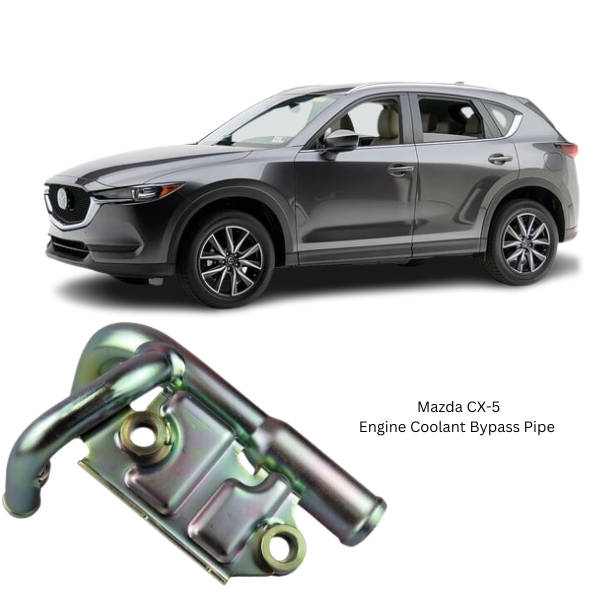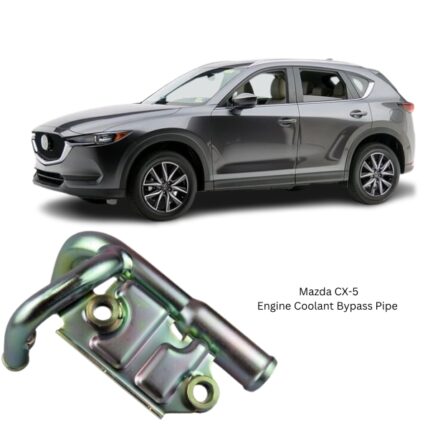Get Mazda CX-5 Engine Coolant Bypass Pipe SH20-15-290A in Kenya
The Engine Coolant Bypass Pipe is a crucial yet often underappreciated component within an internal combustion engine’s cooling system. Its primary function is to facilitate the controlled circulation of coolant through the engine block and cylinder head during specific operational phases—particularly when the thermostat is closed. This allows the engine to reach and maintain optimal operating temperatures more efficiently while preventing hot spots that can lead to thermal damage or engine inefficiency.
While simple in appearance, the bypass pipe is a precision-engineered conduit designed to withstand high temperatures, resist corrosion, and handle constant exposure to coolant fluid under varying pressures. It plays a critical role in regulating coolant flow, improving cold-start behavior, supporting efficient warm-up cycles, and protecting engine longevity.
Function and Role in the Cooling System
The engine coolant bypass pipe is typically a narrow-diameter pipe or tube that creates a flow path for coolant between the water pump and the engine block or between the block and the cylinder head. Its role becomes especially vital during engine warm-up when the thermostat is closed, restricting flow to the radiator.
Key Functions:
-
Regulates Coolant Flow During Thermostat Closure
When the engine is cold, the thermostat remains shut to prevent coolant from reaching the radiator. The bypass pipe ensures that coolant continues to circulate within the engine block, reducing localized overheating. -
Prevents Heat Soak and Hot Spots
Circulating coolant within the engine even before reaching full operating temperature helps eliminate isolated hot areas around combustion chambers, valve seats, or cylinder heads. -
Improves Thermostat Operation
Continuous coolant circulation helps bring the thermostat to operating temperature faster, promoting earlier engagement and more stable regulation of coolant flow. -
Assists in Quick Engine Warm-Up
By allowing internal coolant circulation before radiator involvement, the engine warms up faster—improving emissions, fuel economy, and drivability. -
Supports Heater Core Function
In some designs, bypass coolant flow is partially routed to the cabin heater core, providing faster cabin heat during cold starts.
Design and Construction
The coolant bypass pipe is a compact, durable, and thermally stable component. It must operate within the demanding environment of the engine bay, where exposure to constant vibration, extreme heat, pressurized fluid, and chemical additives is the norm.
Key Construction Features:
-
Tubular Form
Typically cylindrical, with straight or curved geometry based on engine layout. Diameters vary depending on flow requirements. -
Smooth Internal Bore
Allows for unimpeded coolant flow and minimizes turbulence. -
Flanged or Sealed Ends
Designed for secure connection to adjoining components like the water pump housing, thermostat body, or engine block using clamps, O-rings, or gaskets. -
Mounting Brackets or Tabs
In some cases, integrated support tabs or brackets help fix the pipe securely to reduce vibration and wear.
Material Composition
Due to the demanding operating conditions, materials used in coolant bypass pipe construction are selected for durability, thermal resistance, and corrosion protection.
Common Materials:
-
Stainless Steel or Galvanized Steel
Offers high heat resistance and corrosion protection from coolant additives. -
Aluminum Alloy
Lightweight and corrosion-resistant, often used in performance applications. -
Reinforced Plastics or Composite Polymers
Common in modern engines to reduce weight, though more prone to heat degradation over time. -
Rubber (Hose-Based Bypass Tubes)
Used in flexible systems, typically reinforced with textile or synthetic fibers and often secured with hose clamps.
Each material type is chosen based on the layout of the cooling system, temperature cycling frequency, and manufacturer design philosophy.
Placement and Integration
The engine coolant bypass pipe is usually integrated between:
-
The engine block and water pump
-
The cylinder head and thermostat housing
-
The water outlet and the heater core, in certain configurations
Its routing may vary significantly depending on the engine architecture (inline vs. V-type engines) and whether the cooling system uses a bypass thermostat or a separate bypass channel.
Common Issues and Failure Symptoms
Like any engine component subjected to heat and pressure cycles, the coolant bypass pipe is susceptible to aging and wear. Early detection of problems can prevent more serious engine damage.
Common Failure Signs:
-
Coolant Leaks
One of the most common indicators. Leaks may appear around connection points or mid-pipe due to corrosion, cracking, or degraded seals. -
Engine Overheating
A ruptured or blocked bypass pipe can disrupt coolant circulation during warm-up, leading to local overheating or delayed thermostat operation. -
Coolant Odor or Steam Under the Hood
Suggests a leak or rupture under operating pressure. -
Check Engine Light or Engine Temperature Warning
May result from abnormal engine temperature readings or lack of proper thermostat regulation. -
Visible Rust or Scaling
Indicates internal corrosion, common in metal pipes that have not been flushed regularly or where incompatible coolant types have been used.
Replacement and Installation Overview
Replacing a faulty coolant bypass pipe requires care, as it’s often routed behind or between major engine components.
General Steps:
-
Cool Down and Drain Coolant
Allow the engine to cool completely and drain the coolant to below the level of the bypass pipe. -
Remove Obstructions
Depending on location, intake manifolds, alternators, or thermostat housings may need to be removed. -
Disconnect Pipe Connections
Loosen clamps, bolts, or fasteners at both ends. -
Remove Old Pipe
Carefully remove the pipe. If corroded, avoid damaging adjoining parts. -
Clean Mounting Surfaces
Remove old gasket residue or corrosion. Clean with non-abrasive tools. -
Install New Pipe
Fit the new pipe using the appropriate gaskets, O-rings, or seals. Torque all bolts to manufacturer specifications. -
Refill Coolant and Bleed Air
Refill the cooling system and remove any trapped air using the vehicle’s bleed procedures. -
Test Drive and Check for Leaks
Ensure there are no leaks and that the engine warms up normally.
Maintenance Tips
-
Use Compatible Coolant
Always use the manufacturer-recommended coolant type to avoid corrosion inside the pipe. -
Flush Cooling System Regularly
Prevents scale buildup that can narrow the internal passage and restrict flow. -
Inspect During Thermostat Replacement
Since the bypass pipe often connects to the thermostat housing, inspect it during servicing. -
Check Hoses and Clamps
Rubber hoses connected to the pipe should be firm and dry. Replace any that feel soft or show signs of swelling.
Follow us on Facebook for more parts.





Reviews
Clear filtersThere are no reviews yet.